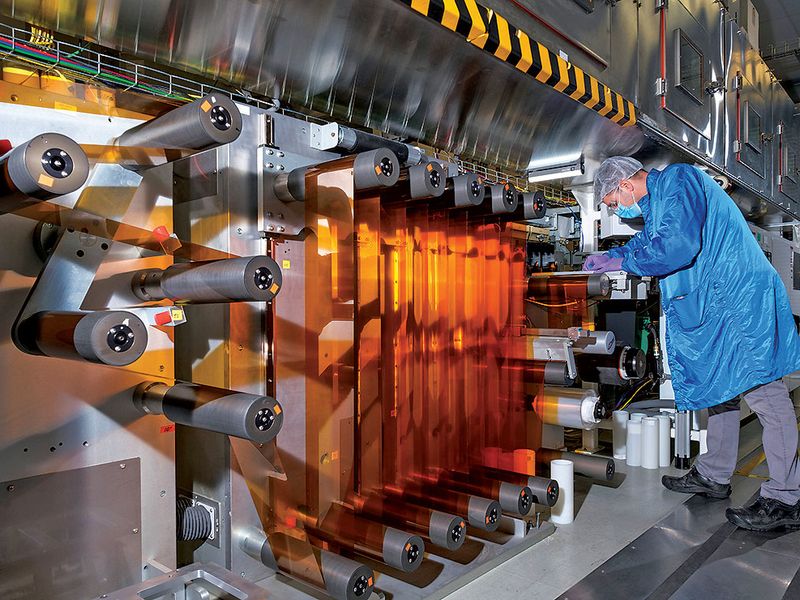
DETROIT — General Motors is retooling more than just cars and trucks as it plots a path toward cleaner skies.
GM envisions its batteries finding their way into other forms of transportation and possibly homes or businesses in the coming years as it seeks to maximize the profit potential and environmental benefits of the costly technologies it’s developing.
“We came into this transformation of electrification as an automaker,” said Charlie Freese, executive director in GM’s hydrogen fuel cell and battery businesses. “We can come out as a provider of propulsion systems for other types of vehicles in different industries.”
The tens of billions of dollars that GM is investing in electrification will go beyond its legacy auto portfolio. The automaker plans to implement its Ultium batteries and Hydrotec fuel cell technology in the locomotive and aviation industries — segments of the transportation landscape it abandoned decades ago. Recent partnerships and electrification plans underscore GM’s confidence in its technology and could mark a shift in the broader transportation ecosystem, experts say.
“At its core, GM is an engineering company,” said David Whiston, equity strategist at MorningStar. “Especially since they’ve been working on hydrogen for a long time, [GM] should be able to do something other than just hydrogen in cars.”
In June, GM said that it would collaborate with Liebherr-Aerospace to develop a hydrogen fuel cell power-generation demonstrator system for aircraft. The demonstrator will be based, in part, on GM’s Hydrotec fuel cell technology and built at Liebherr-Aerospace in Toulouse, France.
GM also announced a partnership with Wabtec Corp. to develop and commercialize GM’s proprietary Ultium battery technology and Hydrotec hydrogen fuel cell systems for Wabtec locomotives.
“By working with GM on Ultium battery and Hydrotec hydrogen fuel cell technologies, we can accelerate the rail industry’s path to decarbonization and pathway to zero-emission locomotives,” Wabtec CEO Rafael Santana said in a statement.
GM has formed a team whose sole focus is deploying Ultium batteries outside the company. Its wireless battery-management system on the Ultium platform simplifies nonautomotive applications, such as in locomotives, said Fiona Meyer-Teruel, GM’s battery electronics and communications systems lead for the Ultium platform.
“We don’t have to revalidate the whole module and its communication system,” she said. “We can just place the number of modules needed inside of the application in various configurations because you have that ease of moving things. You just need a wireless link.”
In the next several years, GM and other automakers’ footprints could extend to the utilities industry, said Mahesh Sudhakaran, general manager for IBM’s energy, environment and utilities industry.
“A few industries are already converging: oil and gas, automotive and the electric industry,” he said. “The automotive industry, including GM and other companies, has an opportunity to really go into new markets and new business models as these industries merge.”
Automakers already are harnessing electricity in ways that go beyond traditional automotive sales and manufacturing. GM has partnered with Qmerit to cover the cost of charger installation at Chevrolet Bolt buyers’ homes, and a handful of automakers have linked with charging companies to expand infrastructure nationwide.
The vehicles themselves can become electrical generators. Some residents of Texas affected by a major power outage in February used Ford Motor Co.’s F-150 hybrid pickups to power their homes.
Automakers’ involvement in power generation is likely to grow significantly as their battery technology advances, Freese said.
“I don’t just mean small generators you see outside of a business or a house,” he said. “You can find a lot of ways that the technology we’re working on spreads out into these broader applications.”
Locomotive power is familiar ground for GM. In 1930, GM purchased Electro-Motive Engineering Co., along with its engine supplier Winston Engine Co.
Winston built gasoline-powered engines for Electro-Motive, but it struggled to implement its diesel engines in trains. Diesel engines were primarily used in the marine industry at the time.
GM engineer Charles Kettering helped Winston develop a lightweight, eight-cylinder, two-stroke diesel for locomotives. In 1934, the prototype powered the Burlington Zephyr train as it set a speed record from Denver to Chicago in 13 hours and five minutes, earning wide acclaim while nearly all trains were still running on steam.
Four years later, GM had begun building locomotives in La Grange, Ill. By 1962, U.S. railroads had transitioned from steam to diesel. GM’s Electro-Motive Division became the world’s leading manufacturer of diesel locomotives.
GM sold the Electro-Motive Division in 2005 to private equity partners after analysts pushed the struggling company to focus on its core automotive business.
GM also has a history with aviation, though its projects in that space were more turbulent.
It bought its first airplane manufacturer in 1919 and added stakes in two more a decade later. In 1933, GM bought a controlling interest in North American Aviation, which bought and sold interests in airline and aviation-related companies.
But in 1934, Congress passed the Air Mail Act, which prohibited companies that were involved in aircraft manufacturing from owning stock in an airline company. GM exited the aviation business in 1948.
Today, GM is working its way back into the aviation and locomotive fields through partnerships with companies that share its vision of zero crashes, zero congestion and zero emissions.
“Collaboration helps you get the volume as fast as possible,” said Freese, whose responsibilities include overseeing GM’s previous-generation battery platforms and Hydrotec technology.
“We are doing a lot of work to find the companies that have the same kind of mindset we do in how to apply the new technologies,” he said. “They want to find a solution that’s both feasible from a sustainability perspective, on an environmental basis, as well as on a business basis.”

